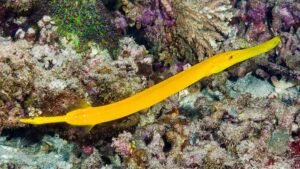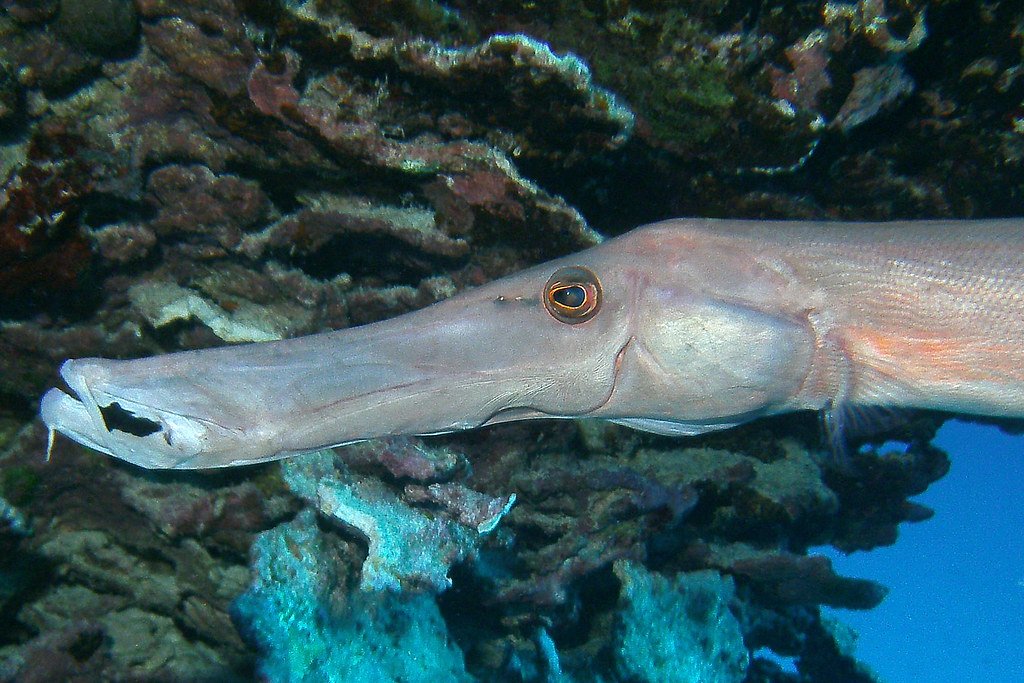Exploring the Fascinating World of Trumpet Fish
Trumpet fish are a captivating species that inhabit the warm waters of the Atlantic, Pacific, and Indian Oceans. Known for their distinctive elongated bodies and vivid coloration, these intriguing creatures have garnered significant interest from marine biologists and enthusiasts. The trumpet fish’s body can grow up to three feet in length, and its narrow, tube-like shape sets it apart from other species. This unique form allows it to blend seamlessly into its surroundings, often mimicking the appearance of sea rods, sea whips, or even large predators to ambush prey.
One of the most striking features of the trumpet fish is its coloration. These fish exhibit a range of vibrant hues, from yellow and green to deep blue and brown. Their colors can change depending on their environment and mood, further aiding in camouflage and communication. This adaptability in appearance not only serves as an effective defense mechanism but also fascinates researchers studying their behavior and ecology.
Trumpet fish are part of the Aulostomidae family and exhibit behaviors and characteristics that contribute to their allure. They are slow swimmers, often seen hovering vertically among coral reefs, seagrasses, or rocky substrates. This behavior helps them remain inconspicuous to both predators and prey. Additionally, trumpet fish possess a specialized hunting technique, using their elongated snouts to suck in unsuspecting smaller fish and invertebrates.
Marine biologists and aquarium enthusiasts are particularly drawn to trumpet fish due to their distinctive appearance and fascinating behavioral patterns. Their ability to adapt and thrive in various marine environments makes them a valuable subject of study in understanding oceanic ecosystems. The combination of their unique body shape, vibrant colors, and intriguing habits ensures that trumpet fish continue to captivate those who encounter them both in the wild and in captivity.
Feeding Habits of Trumpet Fish
Trumpet fish are renowned for their predatory nature, exhibiting a fascinating array of feeding habits that make them effective hunters in their marine habitats. Their diet primarily consists of small fish and crustaceans, which they capture through a combination of stealth and agility. The trumpet fish’s elongated, slender body plays a crucial role in its hunting strategy, allowing it to blend seamlessly into its surroundings, often resembling the seagrass or coral it inhabits.
One of the most remarkable aspects of the trumpet fish’s hunting technique is its ability to remain motionless for extended periods, patiently waiting for unsuspecting prey to wander within striking distance. This behavior, known as ambush predation, is complemented by the fish’s ability to change color, further enhancing its camouflage. When a suitable target is within range, the trumpet fish employs a sudden burst of speed to snatch its prey with its long, tubular snout, which creates a vacuum effect, sucking the prey into its mouth.
The trumpet fish’s diet is diverse, yet it predominantly includes small fish such as gobies, blennies, and juvenile wrasses. Crustaceans like shrimp and small crabs also form a significant part of their diet. These prey items are typically abundant in the coral reefs and seagrass beds where trumpet fish are commonly found. The availability of such prey is critical to the trumpet fish’s survival, influencing their distribution and habitat preference.
Moreover, trumpet fish often employ a unique hunting strategy known as shadow stalking. They follow larger, non-predatory fish, using them as cover to approach their prey undetected. This behavior not only provides an effective means of concealment but also allows trumpet fish to exploit the hunting efforts of other species, capturing prey that is flushed out by the movements of their larger companions.
In summary, the feeding habits of trumpet fish are a testament to their adaptability and predatory efficiency. Their ability to blend into their environment, coupled with their swift, stealthy movements, makes them formidable hunters in the underwater world, maintaining a delicate balance within their ecosystem.
Courtship and Reproduction
Trumpet fish, members of the family Aulostomidae, exhibit captivating and intricate courtship behaviors that are essential for their reproductive success. During the mating season, male trumpet fish engage in elaborate dances and displays to attract potential mates. These rituals often involve synchronized swimming, rapid body movements, and color changes that serve to showcase the male’s fitness and vitality to the female.
The courtship dance is a critical component of the mating process, as it not only attracts the female but also establishes the male’s suitability as a mate. Males may perform a series of rhythmic movements, sometimes involving the erection of their dorsal fins and the display of bright colors or patterns along their elongated bodies. These visual signals are complemented by the male’s ability to maintain close proximity to the female, often swimming in parallel or spiraling around her.
Once a female selects a mate, the spawning process begins. Trumpet fish are known to be pelagic spawners, releasing their eggs and sperm into the open water. This method of external fertilization ensures that the eggs are widely dispersed, increasing the chances of survival in the vast ocean environment. The fertilized eggs drift with the currents, eventually hatching into larvae.
The development of trumpet fish larvae is a critical stage in their lifecycle. After hatching, the larvae are planktonic, meaning they float freely in the water column and are carried by ocean currents. During this stage, they are highly vulnerable to predation and environmental factors. As they grow and develop, the larvae undergo a series of morphological changes, gradually resembling the adult trumpet fish in shape and behavior.
The journey from egg to adult is fraught with challenges, but successful reproduction ensures the continuation of trumpet fish populations. Understanding their courtship and reproductive behaviors provides valuable insights into the complex lives of these fascinating marine creatures and highlights the importance of preserving their natural habitats to support their lifecycle.
Natural Habitat of Trumpet Fish
Trumpet fish, known for their elongated bodies and distinctive trumpet-shaped mouths, are predominantly found in tropical and subtropical seas. Their natural habitats include coral reefs, seagrass beds, and mangroves, each offering unique environmental conditions that support their survival and growth.
One of the primary habitats for trumpet fish is coral reefs. These vibrant ecosystems provide an abundance of hiding spots and feeding opportunities. The complex structures of coral reefs offer protection from predators and enable trumpet fish to blend in with their surroundings. Their ability to mimic the colors and textures of the coral further aids in their camouflage, making them effective ambush predators.
Seagrass beds are another essential habitat for trumpet fish. These underwater meadows, composed of flowering plants, are rich in biodiversity and serve as crucial nursery areas for many marine species. For trumpet fish, seagrass beds offer a plentiful supply of small fish and invertebrates, which constitute their primary diet. The dense vegetation also provides excellent cover, allowing trumpet fish to stealthily approach their prey.
In addition to coral reefs and seagrass beds, mangroves play a vital role in the life of trumpet fish. Mangrove forests, with their intricate root systems, provide a safe haven for juvenile trumpet fish. The labyrinthine roots offer protection from larger predators and strong currents, creating an ideal environment for young trumpet fish to develop before venturing into more open waters.
Geographically, trumpet fish are widely distributed across the Indo-Pacific region, extending from the eastern coast of Africa to the central Pacific Ocean. They are also found in the Atlantic Ocean, particularly around the Caribbean Sea and the Gulf of Mexico. The warm, shallow waters of these regions, with abundant marine life and complex habitats, are conducive to the thriving populations of trumpet fish.
Understanding the importance of these habitats is crucial for the conservation of trumpet fish. Protecting coral reefs, seagrass beds, and mangroves is essential to ensure the continued survival of trumpet fish populations. These environments not only support the ecological balance but also contribute to the overall health of marine ecosystems.
Different Varieties of Trumpet Fish
The world of trumpet fish is diverse, comprising multiple species that display a range of unique characteristics. Among the most notable varieties are the Atlantic trumpetfish (Aulostomus maculatus) and the Chinese trumpetfish (Aulostomus chinensis). Each species exhibits distinct features in terms of size, coloration, and habitat preferences.
The Atlantic trumpetfish is widely recognized for its elongated, slender body and its ability to change color. Typically, these fish can reach up to 80 cm in length and are found in the warm waters of the western Atlantic Ocean, from Florida down to Brazil. Their coloration varies significantly, often displaying shades of brown, yellow, or even blue, which allows them to blend seamlessly with their surroundings. This adaptive camouflage is particularly effective in coral reefs, where they often reside.
On the other hand, the Chinese trumpetfish is predominantly found in the Indo-Pacific region, including the waters off Japan, Australia, and the East African coast. Slightly larger than their Atlantic counterparts, Chinese trumpetfish can grow up to 90 cm. Their coloration is generally more muted, ranging from a pale yellow to a subtle green, which suits their preferred habitats of seagrass beds and coastal lagoons. Unlike the Atlantic trumpetfish, the Chinese variety tends to be more solitary, often seen hovering near the seabed or among rocks.
Additionally, there are other lesser-known species of trumpet fish that populate various oceans across the globe. These include the West African trumpetfish (Aulostomus strigosus) and the Brazilian trumpetfish (Aulostomus brasiliensis), each with its unique adaptations and habitats. The West African trumpetfish, for instance, is often found along the coastlines of West Africa, while the Brazilian variety is indigenous to the coastal waters of South America.
Understanding the differences among the various trumpetfish species not only enriches our knowledge of marine biodiversity but also underscores the importance of conserving their diverse habitats. Each variety contributes uniquely to the ecological balance of its environment, making the study of trumpet fish an intriguing subject for marine biologists and enthusiasts alike.
The trumpet fish plays a crucial role in maintaining the balance of its ecosystem. Positioned as both predator and prey within the marine food web, trumpet fish help regulate the populations of smaller fish and crustaceans. By preying on species such as shrimp, small fish, and other invertebrates, they help control these populations, thereby preventing any single species from becoming overly dominant and disrupting the ecological equilibrium.
In addition to their role as predators, trumpet fish are also prey for larger marine animals, including sharks, larger fish, and occasionally marine mammals. This dual position underscores their importance in the trophic dynamics of their habitats. By serving as both consumers and a food source, trumpet fish contribute to the energy transfer across different trophic levels, which is essential for a balanced and functioning ecosystem.
Trumpet fish also have a symbiotic relationship with certain marine species. For instance, they are known to exhibit a behavior called “shadow stalking,” where they closely follow larger, non-predatory fish, such as parrotfish or groupers. This behavior allows them to blend into the background and ambush unsuspecting prey. Such interactions highlight the complex interdependencies among marine species, underscoring the trumpet fish’s role in the broader ecological network.
Moreover, trumpet fish are integral to the health of coral reefs. Their predation on smaller organisms helps prevent these species from overgrazing on coral and algae, which can lead to reef degradation. By maintaining these populations at sustainable levels, trumpet fish support the resilience and biodiversity of coral reef ecosystems. Healthy coral reefs, in turn, provide essential habitat and resources for a wide array of marine life, fostering a rich and diverse marine environment.
Overall, the trumpet fish is a vital player in marine ecosystems, contributing to the stability and health of their habitats. Their predation and prey roles, symbiotic relationships, and impact on coral reefs all underscore their ecological significance and the intricate balance of marine life.
The relationship between trumpet fish and humans is multifaceted, encompassing aspects of the aquarium trade, the impact of fishing practices, and the challenges posed by habitat destruction. Trumpet fish, with their unique appearance and intriguing behaviors, have become a popular choice among aquarium enthusiasts. Their elongated bodies and distinctive hunting techniques make them a fascinating addition to both public and private aquariums. However, the demand for these fish in the aquarium trade has raised concerns about their sustainability in the wild.
Fishing practices also play a significant role in the lives of trumpet fish. While they are not generally targeted for commercial fishing, they can be caught as bycatch in nets and traps intended for other species. This incidental capture can lead to a decline in trumpet fish populations, particularly in areas where fishing activities are intense. Additionally, habitat destruction due to coastal development, pollution, and climate change further threatens their natural environments. Coral reefs, seagrass beds, and mangroves, which serve as crucial habitats for trumpet fish, are increasingly at risk.
Conservation efforts are essential to ensure the survival of trumpet fish populations. Marine protected areas (MPAs) have been established in various regions to safeguard critical habitats and reduce the impact of human activities. These MPAs provide a refuge for trumpet fish and other marine species, allowing ecosystems to recover and thrive. Additionally, initiatives to promote sustainable fishing practices and reduce bycatch are crucial in mitigating the adverse effects on trumpet fish populations.
Public awareness and education are also vital components of trumpet fish conservation. By understanding the importance of preserving their habitats and the threats they face, individuals can make informed choices that contribute to the protection of these remarkable creatures. Supporting sustainable aquarium trade practices, advocating for stronger environmental regulations, and participating in conservation programs are ways in which people can actively contribute to the preservation of trumpet fish and their ecosystems.
Interesting Facts and Myths
The trumpet fish, belonging to the family Aulostomidae, is a unique marine species that captivates enthusiasts with its distinctive physical appearance and enigmatic behavior. One intriguing fact about the trumpet fish is its remarkable ability to blend into its surroundings. Utilizing its elongated, slender body, the trumpet fish often aligns itself vertically with sea fans or coral branches, effectively camouflaging from predators and unsuspecting prey.
Another fascinating aspect of trumpet fish biology is their feeding mechanism. Unlike many other fish, trumpet fish employ a stealthy hunting technique. They often shadow larger, non-threatening fish to get closer to their prey unnoticed. When the moment is right, they use a rapid sucking motion to engulf their target, showcasing impressive predatory skills. This method of ambush predation underscores their adaptability and resourcefulness in the wild.
Beyond their biological traits, trumpet fish have also woven themselves into cultural tapestries. In various coastal communities, they are often seen as symbols of agility and patience. Their ability to remain motionless for extended periods has inspired local folklore, attributing them with mythical patience and wisdom. These cultural attributions add a layer of mystique to their already fascinating profile.
However, like many marine creatures, trumpet fish are not immune to myths and misconceptions. One common myth is that trumpet fish are dangerous to humans. In reality, they pose no threat to people and are generally shy, preferring to avoid human interaction. Another myth suggests that trumpet fish can produce musical sounds, likely due to their name. This, however, is purely fictional as trumpet fish lack the anatomical structures necessary for sound production.
Understanding these interesting facts and debunking common myths provides a comprehensive view of the trumpet fish’s role in marine ecosystems. It highlights their unique adaptations, intriguing behaviors, and the cultural significance they hold for many coastal societies, enhancing our appreciation for these remarkable marine creatures.
